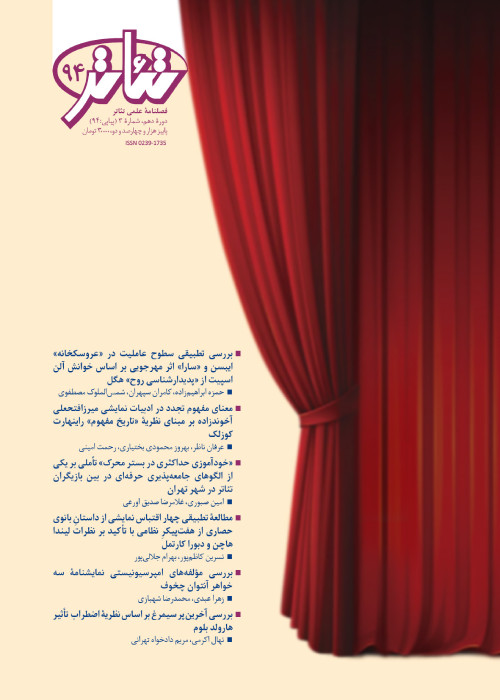A comparative study of four dramatic adaptations of the story of Banu-ye Hesari from Nizami’s Haft Paykar with emphasis on the comments of Linda Hutcheon and Deborah Cartmell
Author(s):
Article Type:
Research/Original Article (دارای رتبه معتبر)
Abstract:
The treasure of Persian literature is considered a huge source for adapting and creating dramatic works, and Khamsa Nizami is one of the most important and appropriate works in this treasure. In the Tuesday Night episode of the Nizami’s Haft Paykar in the red dome, the story of Banu-ye Hesar is told. This story, which was called Turandekht after its adaptation, has been dramatically adapted many times because of its charm and elements of the story. For the first time, the Italian writer Carlo Gozzi made a Commedia dell’arte adaptation of Turandekht in the 18th century. Then, the German Schiller welcomed Gozzi’s play and wrote his Turandecht, and Berthold Brecht made a theatrical adaptation of this work after years of studying Chinese philosophy. In Iran, Reza Karam Rezaei has used the story of Turandecht as a basis for adaptation in the style of Takht Hozei. In this article, to determine the dramatic aspects of the story of Banu-ye Hesar and investigate the role of cultural and time factors in the adaptation of the ancient works, the story of Banu-ye Hesar and four theatrical adaptations were studied according to the theories of Hutcheon and Cartmell. The formalistic analysis of the story of Banu-ye Hesar shows that this system has many dimensions of theatrical features. Also, according to Hutcheon’s theory, there has been a change within the media in all the adaptation works mentioned. In the works of Gozzi, Schiller, and Karam Rezaei, the desired military theme is repeated and honored, while in Brecht’s work, the main theme has been turned upside down, and he has risen against it. In addition, based on Cartmell’s classification, it can be said that Gozzi, Schiller, and Karam Rezaei have used the transmission method and Brecht the method of interpretation in adapting the original work.
Keywords:
Language:
Persian
Published:
Theater, Volume:10 Issue: 94, 2023
Pages:
53 to 63
magiran.com/p2691231
دانلود و مطالعه متن این مقاله با یکی از روشهای زیر امکان پذیر است:
اشتراک شخصی
با عضویت و پرداخت آنلاین حق اشتراک یکساله به مبلغ 1,390,000ريال میتوانید 70 عنوان مطلب دانلود کنید!
اشتراک سازمانی
به کتابخانه دانشگاه یا محل کار خود پیشنهاد کنید تا اشتراک سازمانی این پایگاه را برای دسترسی نامحدود همه کاربران به متن مطالب تهیه نمایند!
توجه!
- حق عضویت دریافتی صرف حمایت از نشریات عضو و نگهداری، تکمیل و توسعه مگیران میشود.
- پرداخت حق اشتراک و دانلود مقالات اجازه بازنشر آن در سایر رسانههای چاپی و دیجیتال را به کاربر نمیدهد.
In order to view content subscription is required
Personal subscription
Subscribe magiran.com for 70 € euros via PayPal and download 70 articles during a year.
Organization subscription
Please contact us to subscribe your university or library for unlimited access!


